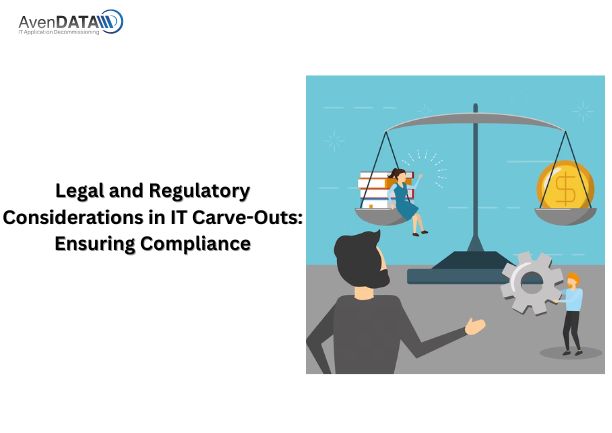
In the intricate landscape of IT carve-outs, where organizations strategically separate segments of their IT infrastructure to create standalone entities, legal and regulatory considerations play a pivotal role. These considerations encompass a broad spectrum of legal and compliance issues that must be carefully navigated to ensure a seamless and legally sound carve-out process. In this blog, we delve into the critical legal and regulatory aspects that organizations need to address when undertaking IT carve-outs to ensure compliance and mitigate potential risks.
Understanding Legal and Regulatory Considerations
Data Privacy and Protection: Data privacy regulations, such as the GDPR in Europe and the CCPA in the United States, impose strict requirements on the collection, processing, and transfer of personal data. In an IT carve-out scenario, organizations must assess data privacy risks, implement appropriate safeguards, and ensure compliance with applicable regulations to protect the privacy rights of individuals.
Intellectual Property Rights: Intellectual property (IP) assets, including patents, trademarks, copyrights, and trade secrets, are often integral to an organization’s IT infrastructure. During a carve-out, organizations must carefully identify, transfer, or license relevant IP assets to avoid disputes and ensure continued protection of proprietary rights.
Contractual Obligations: IT carve-outs may involve the transfer or termination of contracts with third-party vendors, suppliers, and service providers. Organizations must review existing contracts, identify any contractual obligations or restrictions, and negotiate new agreements as necessary to ensure continuity of services and compliance with contractual obligations.
Regulatory Compliance: Organizations operating in regulated industries, such as healthcare, finance, and telecommunications, must comply with industry-specific regulations and standards. During an IT carve-out, organizations must assess regulatory requirements, obtain necessary approvals, and implement compliance measures to mitigate regulatory risks and ensure ongoing compliance.
Employment Law: The transfer of employees from the parent organization to the newly carved-out entity may trigger employment law considerations, including employee rights, benefits, and collective bargaining agreements. Organizations must adhere to applicable employment laws, consult with legal counsel, and implement appropriate measures to address employee-related issues during the carve-out process.
Mitigating Legal and Regulatory Risks
Conducting Due Diligence: Thorough due diligence is essential to identify potential legal and regulatory risks associated with the carve-out. Organizations must assess the legal and regulatory landscape, conduct comprehensive audits, and identify any compliance gaps or liabilities that may impact the carve-out process.
Engaging Legal Counsel: Legal counsel with expertise in IT transactions, corporate law, and regulatory compliance can provide valuable guidance and assistance throughout the carve-out process. Organizations should engage legal counsel early in the process to assess risks, negotiate agreements, and ensure compliance with applicable laws and regulations.
Implementing Compliance Frameworks: Establishing robust compliance frameworks and policies can help organizations proactively address legal and regulatory requirements during the carve-out process. By implementing compliance controls, conducting regular audits, and providing training to stakeholders, organizations can mitigate risks and demonstrate a commitment to compliance.
Maintaining Documentation: Documentation is crucial for demonstrating compliance with legal and regulatory requirements and mitigating potential disputes or liabilities. Organizations should maintain detailed records of legal agreements, regulatory approvals, compliance assessments, and other relevant documentation throughout the carve-out process.
Conclusion
In conclusion, legal and regulatory considerations are paramount in IT carve-outs to ensure compliance, mitigate risks, and facilitate a smooth transition. By understanding the complex legal and regulatory landscape, conducting thorough due diligence, engaging legal counsel, and implementing robust compliance measures, organizations can navigate the carve-out process with confidence and achieve their strategic objectives while safeguarding against legal and regulatory risks.







